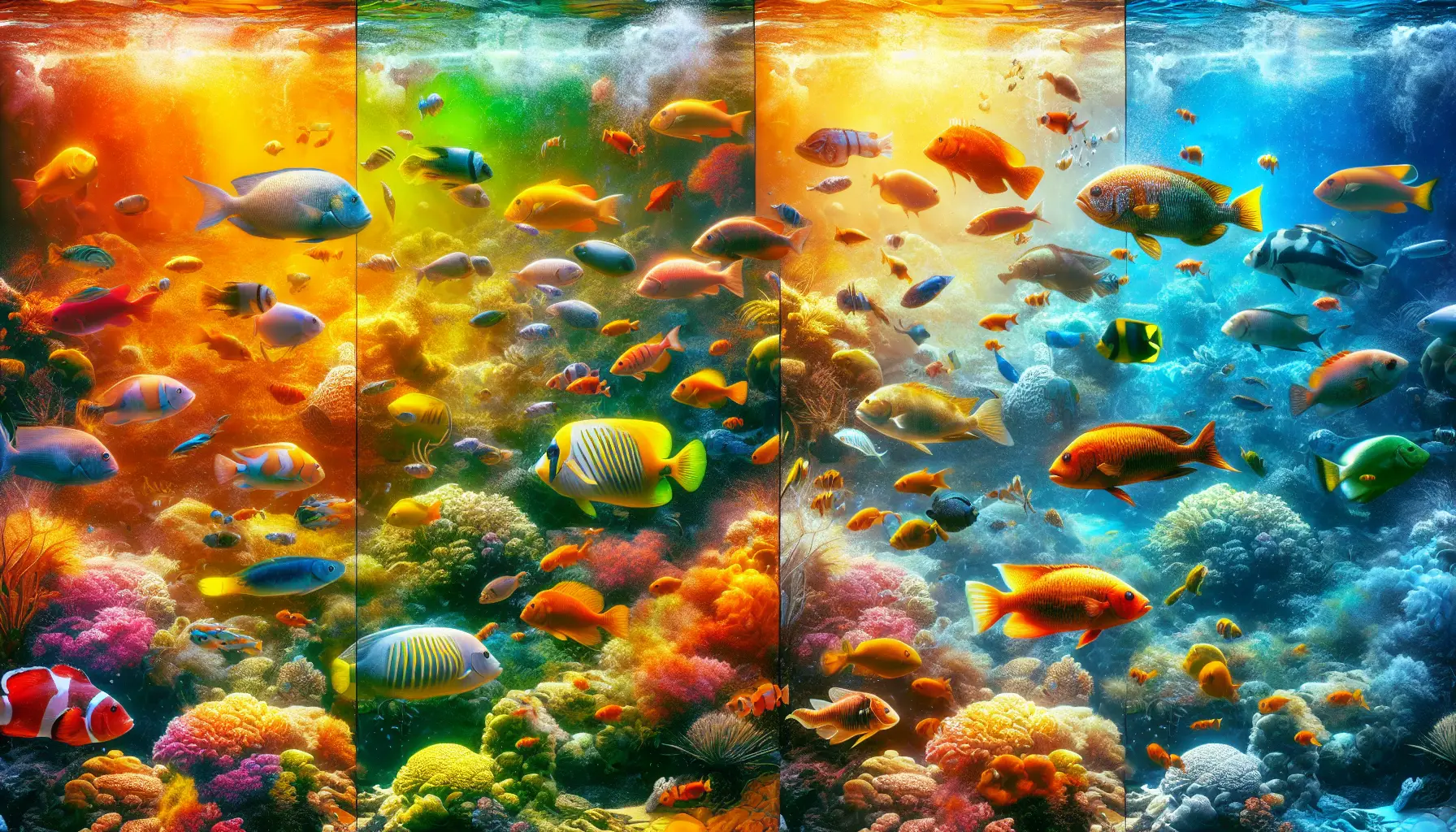Water Temperature and Fish Behavior
Fish activities—a lot like people doing the chicken dance at a wedding—are all over the place depending on how hot or cold the water is. If you’re a fly fisher looking to snag a big one, knowing how temperature messes with fish is like having a secret map.
Impact of Water Temperature on Fish Physiology
Fish, being the chill creatures they are, let the water dictate their body heat and all those processes inside them because they can’t regulate it themselves (NCBI). Different fish are like Goldilocks—they like things just right. Too hot or too cold can mess them up.
- Metabolism: If the water’s warm, fish are on hyperdrive, needing more chow and moving around like they’re late for class. Cold water? They’re more like us on a lazy Sunday—slow and not burning many calories.
- Breathing: When the water heats up, it doesn’t hold as much oxygen, making it tough for fish to breathe. They’re practically gasping, “Hey, throw me a bone here!”
- Growth and Baby Fish: Fish need just the right temperature to grow big and strong and make more fish. When the temperature hits the sweet spot, the little fishlings enter the world. They know when to get busy, and it’s all about those temperature cues.
| Temperature Range | What Happens to the Fish |
|---|---|
| < 40°F | Like fish on a lazy couch day, barely moving |
| 50-70°F | They’re in their happy place, thriving and vibing |
| > 85°F | It’s stress city and could even be lights out |
Fish Movement in Response to Temperature Changes
Fish are like weather reporters—they sense the tiniest changes in temperature and adjust their actions and address. For fishers trying to find them, this is pure gold.
- Thermal Hangs: Fish love a good thermal hangout spot. They find the water pockets where the temperature’s just right. In layered lakes, they might dive deep to find that cold water when things get toasty.
- Big Fish Roadtrip: When the ocean turns up the heat, fish put on a travel cap like they’re going on a summer road trip. Cod and haddock are off, migrating north where they find things cooler (Yale Environment 360).
| Season | Fish Moving Game |
|---|---|
| Spring | They hit the shallows to warm up and maybe find a buddy to spawn with |
| Summer | They’re diving to the cooler depths to avoid sunburn (if fish did that) |
| Fall | Off to the best feeding spots to stock up |
| Winter | Chillin’ in comfy zones to save energy |
Getting cozy with how fish vibe and move with temperature changes isn’t just science—it can make your time with the rod feel magical. You’ll know just where to find them and what they’re up to without asking.
Effects of Climate Change on Fish Behavior
Understanding how climate change messes with fish is a must for anyone trying to keep up in fly fishing. Here, we take a close look at how rising ocean temps and acidifying seas are playing tricks on our finned friends.
Oceanic Temperature Shifts and Fish Migration
As our oceans heat up, fish are taking a road trip to cooler locales, often veering north. Folks in Portugal are spotting nearly 20 new species crashing their waters from toastier regions (Yale Environment 360).
Take the black sea bass for instance. They used to chill around North Carolina, but now they’re packing their bags and setting up shop in Jersey, all thanks to the changing climate.
| Species | Original Spot | New Hangout |
|---|---|---|
| Black Sea Bass | North Carolina | New Jersey |
| Lobsters | Long Island Sound | Gulf of Maine |
Such changes throw a wrench in local ecosystems. Newbies moving in can shove out natives, stirring up a storm. In the Gulf of Maine, butterfish have muscled in, making baby puffins struggle to chow down on them, even risk starving.
Ocean Acidification and Deoxygenation Effects on Fish
Oceans gulping down more carbon dioxide spell trouble, especially for tiny larval fish who find it harder to survive. To make things worse, warmer waters are squeezing oxygen, making fish either adapt by heading to shallower waters or risk keeling over. Those poor bottom-dwellers that can’t pick up and leave, like muck-loving invertebrates, are in a tight spot (Yale Environment 360).
With the heat cranking their metabolic rates, fish need more oxygen just to get by. This leaves them with less room to roam, and species like cod and rock crab are staring at losing a chunk of their habitats, around 14 to 26 percent, due to less oxygen and rising temps.
| Species | Habitat Loss (%) |
|---|---|
| Cod | 14 – 26 |
| Rock Crab | 14 – 26 |
| Eelpout | 14 – 26 |
The climate game is rewriting fish behavior and where they call home. Fly fishermen gotta keep up with these shaking up changes to tweak their tricks and techniques right.
Temperature Influence on Fish Feeding
Temperature’s got its hands in the fish feeding cookie jar, stirring up their munching habits and digestion. Knowing this can turn a good day for die-hard fly anglers into a great one, giving them just the edge they need to reel in the big ones with some inside knowledge.
Relationship Between Temperature and Food Consumption
Fish chow down according to how warm or chilly the water gets. Since they’re ectotherms (big fancy word meaning their body temp mirrors the water), a bit of extra warmth usually makes them hungrier, while stepping outside their temp comfort zone may curb their appetite (NCBI).
Fish rely on their senses—sniffing, seeing, hearing—to hunt down their next meal, and these senses shift with the mercury. Here’s a quick lowdown on how temps mess with their eating habits:
| Temperature Range | Food Intake Behavior |
|---|---|
| Just Right | Big appetite, happy fish |
| Warming Up | They chow down and get bigger |
| Chilly | Appetite shrinks with them |
| Too Hot to Handle | Off their feed, feeling the heat |
Temperature Effects on Digestive Processes in Fish
Temps don’t stop at noshing; they mess with fishy digestion too. Heat or cold influences how fast food passes through, enzyme hustle, and overall nutrient grabbing.
When water is icy, digestion crawls like a snail: nutrients sit, enzymes snooze. At prime temps, it’s a digestion sprint, with nutrients soaking in like magic. Knowing these quirks helps you guess when fish will get the munchies and why.
| Factor | Effect of Low Temperature | Effect of Optimal Temperature |
|---|---|---|
| Gut Transit Time | Longer wait | Smooth sailing |
| Digestive Rates | Slow-mo | Just right |
| Enzyme Activities | Snoozville | Power-hour |
| Nutrient Absorption | Not happening | Spot on |
Fish smart by syncing your tactics with what the water thermometer says. Play it cool or heat things up with the right bait, and you’re that much closer to landing the big one. This little cheat sheet can mean the difference between a day of “almost had it” and a day of “nailed it!”
Human Interventions and Fish Behavior
Damming Effects on Water Temperature and Fish Spawning
Damming rivers really messes with water temps, throwing fish behavior—especially spawning—off balance. When dams alter river temperatures, it can knock crucial temperature marks out of whack for fish gonad development. This means fewer fish get busy spawning.
| Impact on Fish Behavior | Effect Due to Damming |
|---|---|
| Water Temperature | Changed thermal vibes |
| Fish Spawning | Less party in the water |
| Gonad Development | Temp misfit |
Any angler looking to master the art of fish-whispering should be hip to these changes. Success in fly fishing often hangs on catching those subtle fishy shifts in biology and their hangout spots.
Impact of Temperature Rhythms Alteration on Fish Habitat
When rivers get dammed, it’s not just the water that gets blocked—temperature rhythms do too. Reservoir tinkering detaches the flow and temp from their natural beat, throwing a wrench in fish spawning and baby fish recruitment plans in floodplain rivers (Science Direct). These tweaks make it tough for many fish to find comfy homes.
| Factor | Impact Due to Altered Temperature Rhythms |
|---|---|
| Flow Patterns | Off-beat from nature’s tune |
| Fish Spawning | Timing chaos and lower success rates |
| Early Recruitment | Cramped style with bad living situations |
Getting the lowdown on these human-made curveballs is key for top-notch fly anglers looking to predict fish antics and catch a bigger haul. Knowing that dams rewrite Mother Nature’s script can help pinpoint prime fishing spots and moments.

